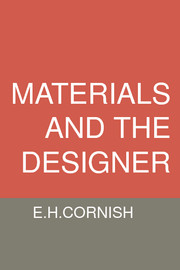Book contents
- Frontmatter
- Contents
- Preface
- Introduction
- 1 The impact of design on manufacturing industry
- 2 Expertise required for the design process
- 3 An introduction to materials
- 4 Properties of metals and alloys
- 5 Properties of ceramics
- 6 Properties of polymers
- 7 Properties of composites
- 8 Materials' performance in service
- 9 Finishes and coatings as protective systems
- 10 Materials reliability and service life
- 11 Factors controlling the selection of substitute materials
- 12 Material forming processes and design
- 13 Sources of information on materials
- 14 Standards and materials
- References
- Bibliography
- Index
5 - Properties of ceramics
Published online by Cambridge University Press: 05 August 2012
- Frontmatter
- Contents
- Preface
- Introduction
- 1 The impact of design on manufacturing industry
- 2 Expertise required for the design process
- 3 An introduction to materials
- 4 Properties of metals and alloys
- 5 Properties of ceramics
- 6 Properties of polymers
- 7 Properties of composites
- 8 Materials' performance in service
- 9 Finishes and coatings as protective systems
- 10 Materials reliability and service life
- 11 Factors controlling the selection of substitute materials
- 12 Material forming processes and design
- 13 Sources of information on materials
- 14 Standards and materials
- References
- Bibliography
- Index
Summary
General characteristics
In the present context, we shall be using ‘ceramics’ and ‘glass’ as terms for ceramic materials intended for engineering applications. Although in some ways one might consider the structure of Portland cement to be allied to that of ceramics, such cement will not be dealt with at all except for later mention of a new development in which porosity has been significantly reduced.
Ceramics are usually based on both metallic and non-metallic elements joined by atomic bonds that are partly ionic and partly covalent. This type of bonding, different from that in other materials such as minerals, gives rise to the characteristic hardness, brittleness and heat resistance of ceramics. Ceramics comprise those inorganic materials (with the exception of metals and their alloys) which have been subjected to a high temperature processing stage to produce solid objects from the powdered starting materials. Ceramics are usually crystalline with single crystals or with dense polycrystalline masses, but there also exist composite materials with ceramic crystallites bonded into a glassy matrix, as well as the totally non-crystalline glasses. The general structure of these materials is seen in Figure 5.1.
In the crystalline materials, atoms are joined together in a repetitive pattern which follows through from one basic unit of molecular structure to the next, so that a regular array of atoms is seen on the larger scale.
- Type
- Chapter
- Information
- Materials and the Designer , pp. 79 - 90Publisher: Cambridge University PressPrint publication year: 1987



